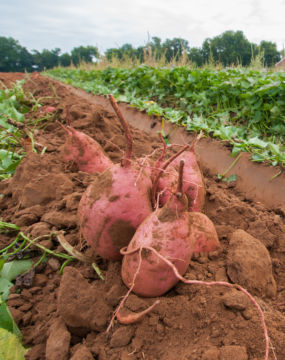Fun Maps
Keep up with our latest demographic insights

Picture this: You’re at a demography dinner party. (Let’s pretend we can have dinner parties again.) And the demography enthusiast next to you says, “Hey! Got a question for you. Which county in North Carolina is most like the state?” How would you answer? First, you’d want to know what parameters to include – e.g. what factors to consider in thinking through how to calculate your answer. To do that, we can start with an…

North Carolina’s agricultural industry contributes $84 billion to the state’s economy and employs more than 1 in 6 North Carolina Workers, according to the Department of Agriculture & Consumer Services. Two of the state’s lead agricultural products—sweet potatoes and turkeys—will grace many Thanksgiving tables on Thursday. Here’s a quick look at sweet potatoes by the numbers: 1st North Carolina’s rank in sweet potato production. North Carolina has led the nation in sweet potato production since…

As the month of October comes to a close, we reach the first holiday of the autumn season: Halloween. To help you prepare, we’ve put together a guide to the number of trick-or-treaters in the state this year, and a map of where one can expect to get the most visitors! We’ve also run the numbers on North Carolina’s contribution to the holiday, by way of its numerous candy factories and stores. This year, we…
Between 1920 and 2010, North Carolina's population increased from 2.6 million residents to more than 9.5 million residents. With nearly 80,700 residents in 1920, Mecklenburg was the state's most populous county then as it is today. But in 1920, Mecklenburg only held 3.2% of the state's population compared to its current share of 10 percent. This share is projected to increase to nearly 12% by 2030. The video below highlights shifts in North Carolina population across…
The USDA Economic Research Service produces a lot of data about our nation's farms and food stuffs. Recently, they made their series of "the essentials" into an easy to navigate portal, filled with 70 charts and maps that highlight key information about everything from food prices and consumption to the interplay between agriculture and natural resources. While it's well worth exploring on your own, here were three of my favorites: The number of U.S. farms…
Two fundamental processes underpin population growth—or decline. The first, natural increase (or natural decrease) captures the balance of births and deaths in an area and reflects the underlying age structure of the population. Relatively young populations tend to have more births than deaths, or natural increase. Relatively older populations, on the other hand, tend to experience natural decrease, more deaths than births. The second, net migration, reflects the appeal of an area relative to other…
North Carolina had nearly 9 times as many textile machine operators than would be expected based on national averages, according to recent analysis of Bureau of Labor Statistics data by the Pew Charitable Trusts. Georgia had more than 10 times as many textile machine operators than would be expected. In these two Southern states, the relatively high concentration of these jobs—as compared to national averages—reflects historical economic patterns that persist today. Nationwide, just over 75,000…
“Some places attract young singles, whereas others attract married couples and families,” writes Nathan Yau on his data visualization blog, Flowing Data. This is something that I often discuss when I present to audiences around the state: places have age-specific migration profiles that reflect both the reasons why people are moving to a place, and the potential demands that they will have when they get there. Some places, like Mecklenburg County, have net migration profiles…
According to the Quarterly Census of Employment and Wages, the 10 largest employers in the state of North Carolina are universities, hospitals, public schools, and banks. Duke University in Durham was the state’s largest employer in the 2nd Quarter of 2014, followed by Charlotte Mecklenburg Hospital and Wake County Public Schools. The Triangle’s other major research institutions—UNC-Chapel Hill and NC State University—were the 4th and 8th largest employers in the state, respectively. Four of the 10 largest…
“More and more, the U.S. economy is defined by its metropolitan areas,” writes Richard Florida at The Atlantic’s CityLab blog. Just over 90% of the nation’s economic activity occurs in metro regions. In North Carolina, the state’s 15 major metropolitan regions also comprised the majority of economic activity, but at a level less than the national share. In 2013, the state’s combined metro GDP was $407 billion out of a total GDP of $471 billion.…
Your support is critical to our mission of measuring, understanding, and predicting population change and its impact. Donate to Carolina Demography today.